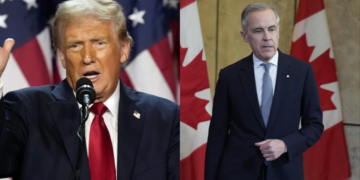If you’re checking your stock app today and feeling like your portfolio just got body-slammed—you’re not alone. The Dow Jones Industrial Average tumbled a jaw-dropping 1,100 points today, marking one of the sharpest single-day declines in recent memory. The big question on everyone’s mind? What just happened to Dow Jones today—and is this the start of something bigger?
Trade Wars: The Sequel No One Asked For
Wall Street is no stranger to volatility, but today’s drop wasn’t just about bad vibes—it was about bad blood between economic superpowers. The U.S. and China have once again locked horns, and this time, it’s serious.
After President Trump’s administration raised tariffs (again) on Chinese imports, Beijing hit back hard with a retaliatory 34% tariff on all U.S. goods. Investors were already on edge, but this move sent a crystal-clear message: this isn’t just posturing—it’s war. A trade war! And when superpowers go to economic battle, guess who ends up caught in the crossfire? Yep—everyone.
Down Jones Today: Tech Stocks Took the Hit First

Remember the invincibility cloak we thought big tech wore? Turns out, it’s a little torn. Apple dropped over 2.7%, continuing a multi-day slump. Nvidia got hammered with a 5% drop, and Tesla, ever the drama queen of Wall Street, fell 6%.
Chinese giants like Alibaba and Baidu didn’t fare any better. Globalization means your favorite app developer in Silicon Valley is suddenly vulnerable to a policy shift halfway around the world.
If you thought tech had it bad, take a peek at the industrials. Boeing, which heavily relies on global exports, saw its stock nosedive over 11%. Goldman Sachs followed with a 9.4% loss. Just those two stocks alone wiped out nearly 400 points from the Dow Jones today. It wasn’t a correction. It was a collapse.
The Domino Effect: From Wall Street to Your Wallet
What makes this so dangerous is the psychological momentum. When the market falls this fast, fear feeds fear. The Volatility Index (VIX)—Wall Street’s “fear gauge”—spiked dramatically, hinting at deeper panic under the surface. And yes, this trickles down. If you’re wondering whether your 401(k) took a hit or if borrowing is about to get tighter—the answer is probably yes to both. Markets don’t crash in a vacuum. Real people feel the ripple effects.
But Wait—Jobs Are Up?
In a bizarre twist, today also brought some good economic news: the U.S. added over 220,000 new jobs in March, beating expectations. The unemployment rate ticked up ever so slightly to 4.2%, but overall, the labor market looks… shockingly solid.
So, how do we square this with the market meltdown? Simple: Wall Street isn’t reacting to it today—it’s pricing in what it fears about tomorrow.
It’s Not Just Us—Global Panic Is Real
What happened in New York didn’t stay in New York. The FTSE 100 in the UK, Germany’s DAX, and Japan’s Nikkei all followed suit. Australia’s ASX 200 dropped 2.4%. Across continents, red lit up trading screens like warning signals on a sinking ship.
Markets around the globe are bracing for a long, cold economic winter if the U.S.-China trade brawl escalates any further. So… Should You Panic? Be cautious, but don’t hit the sell button out of fear.
Corrections and crashes are part of the cycle. Smart investors use downturns to strategically reposition, not react emotionally. That said, if you’re highly exposed to international sectors or high-risk tech, now might be a good time to rebalance your portfolio.
And for the love of diversification—spread those eggs across more baskets.
The Dow Doesn’t Lie—But It Doesn’t Tell the Whole Truth Either
Dow Jones Today was brutal. There’s no sugar-coating it. But panic doesn’t pay. Markets may bounce back tomorrow—or plunge further. What matters most is keeping your cool, staying informed, and resisting the urge to make decisions based on headlines alone.















Discussion about this post